Winix 5300-2 Review
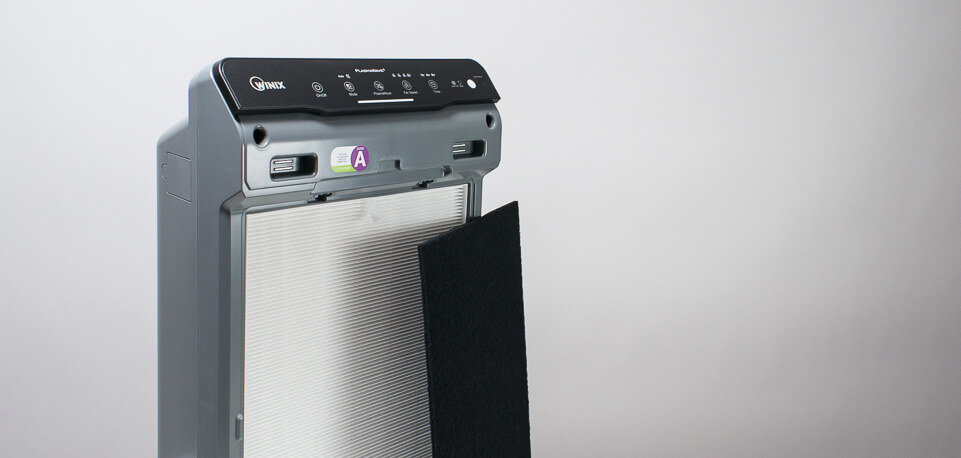
Feature Scores
Pros
- Versatile – high output with multiple fan speeds allows it to be used in small and large rooms
- True HEPA filter at a low cost – industry standard particle filtration at a very competitive price point
- Great energy efficiency – low power costs which is especially meaningful if the air purifier is used multiple hours out of the day
- Great build quality and quality of materials
- Matte finish is good for keeping dust from collecting on the air purifier
Cons
- 1 year warranty – most other air purifiers on the market come with at least a 3 to 5 year warranty
- Carbon filter is comprised of a fibrous material coated with carbon – less effective than carbon pellets
Editor's Score
Quick Facts
| Particle filter type | HEPA |
|---|---|
| Gas filter type | Carbon |
| Pre-Filter | Mesh washable pre-filter |
| Output | Approx. 250 CFM |
| Air Movement | Front, bottom, sides of front grille > mesh pre-filter > carbon filter > HEPA filter > up and out of top of unit |
| Number of fan speeds | 4 – low, medium, high, and turbo |
| Size | 24 in. tall x 15 in. wide x 8 in. deep |
| Weight | 15 lb. |
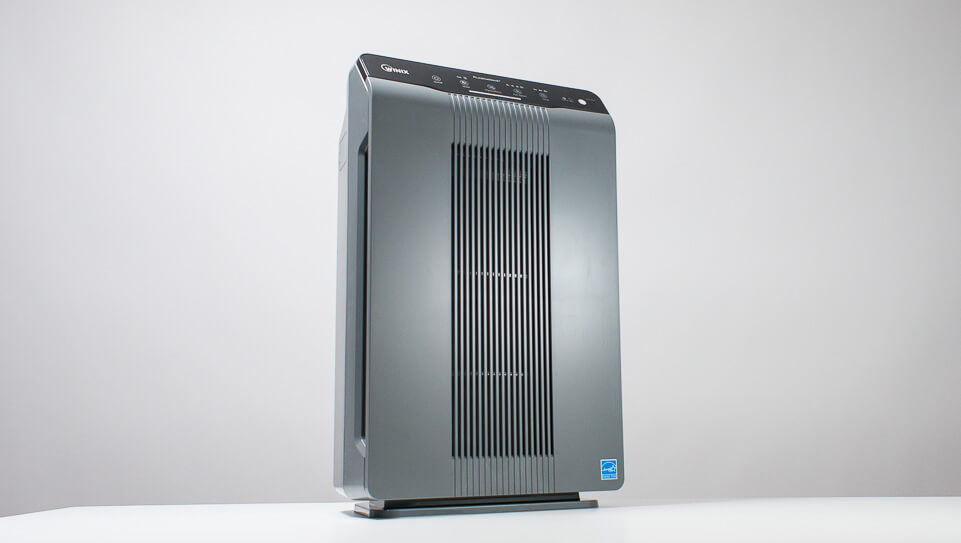
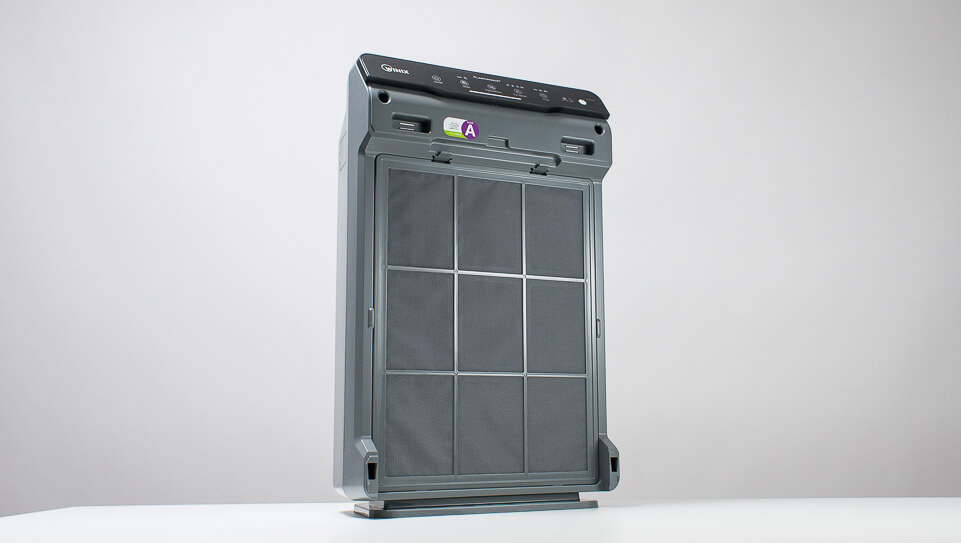
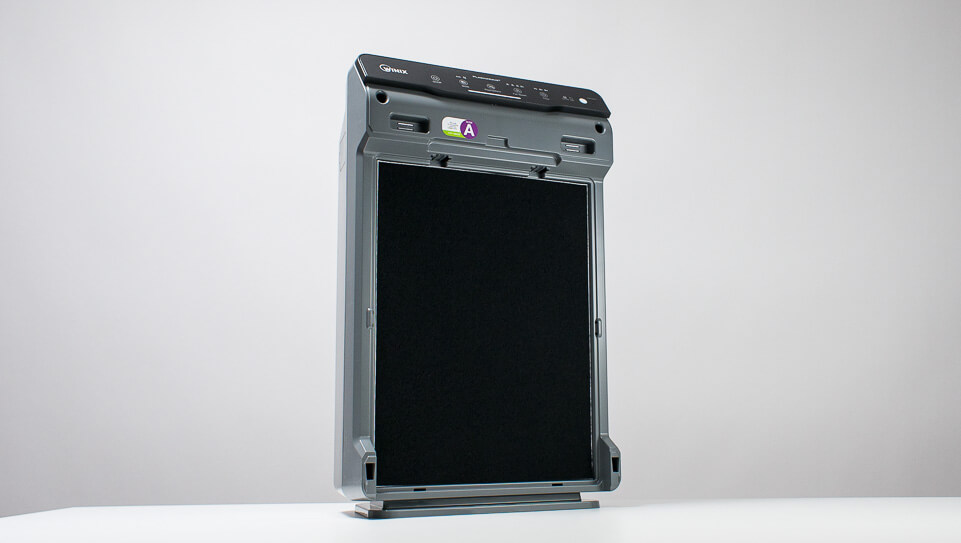
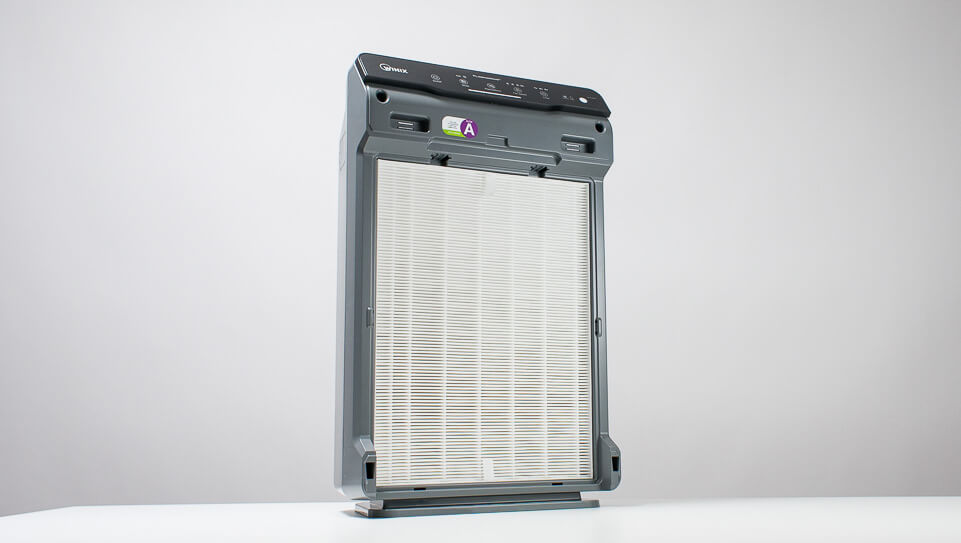
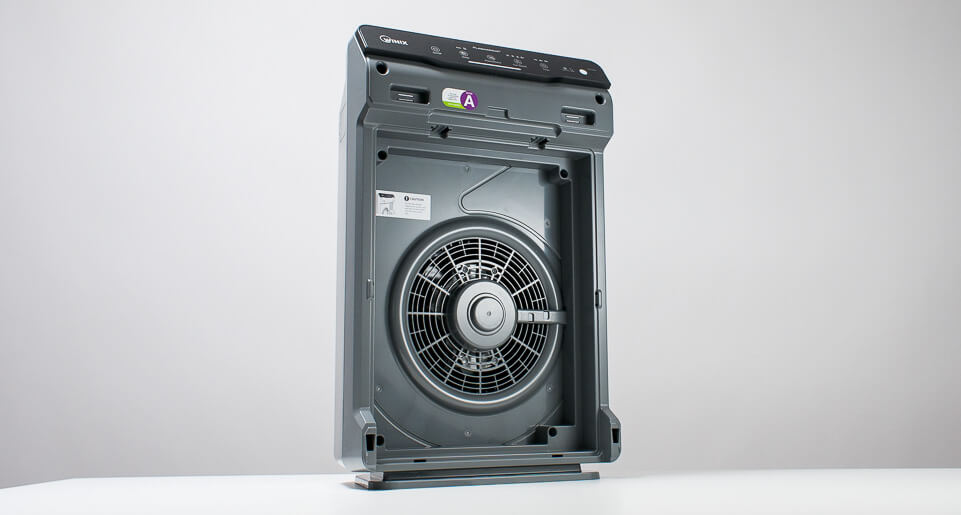
Analysis
A step by step breakdown of the 5300-2's performance.
Air Processing Performance
Test Results
In a 150 sq. ft. test environment, the Winix 5300-2 was able to lower room particle concentration from 10,000 particles per cubic ft. down to 1,000 particles per cubic ft. in 9 minutes. We consider the latter concentration – 1,000 particles per cubic ft. - to be the maximum threshold for particle concentration in a clean air environment in a residential setting. Thus, the 5300-2 is able to achieve a “clean air” environment in a 150 sq. ft. room in 9 minutes. This is, of course, on its highest fan speed – turbo.
Comparable models also equipped with HEPA filters and also outputting at approx. 250 CFM garnered similar results. The Winix 5500-2 accomplished the same feat in exactly the same amount of time – 9 minutes. The Coway Mighty took 10 minutes.
Smaller units with less output (less CFM) took longer. For example, the GermGuardian AC4825 took 23 minutes. Larger units with greater output were faster. For example, the Coway AirMega 400 took only 4 minutes.
The Winix 5300-2 was able to lower particle concentration in the room even further given more time. Given an additional 7 minutes it was able to achieve the lowest particle concentration possible – 100 particles per cubic ft. (this was as close to 0 as we were able to measure). The Winix 5500-2 took an additional 6 minutes and the Coway Mighty took an additional 13 minutes.
The GermGuardian AC4825 needed an additional 40 minutes while the Coway AirMega 400, surprisingly, needed 9 additional minutes.
All of this is to say that the Winix 5300-2 was one of the top performers we tested in lowering room particle concentration down to the lowest concentration possible as quickly as possible.
Filter Analysis
Particle Filter
The 5300-2 is equipped with a single HEPA filter to filter out particles from the air. Particles include everything from pollen and pet allergens to mold and dust.
HEPA filtration is the industry standard for particle filtration. A HEPA filter removes 99.97% of particles that travel through it. For comparison, a MERV 7 filter, commonly used in residential HVAC systems, removes only 90% of particles that travel through it.
All of the air purifiers we’ve mentioned so far - including the Winix 5500-2, Coway Mighty, GermGuardian AC4825, and Coway AirMega 400 - also come equipped with HEPA filters.
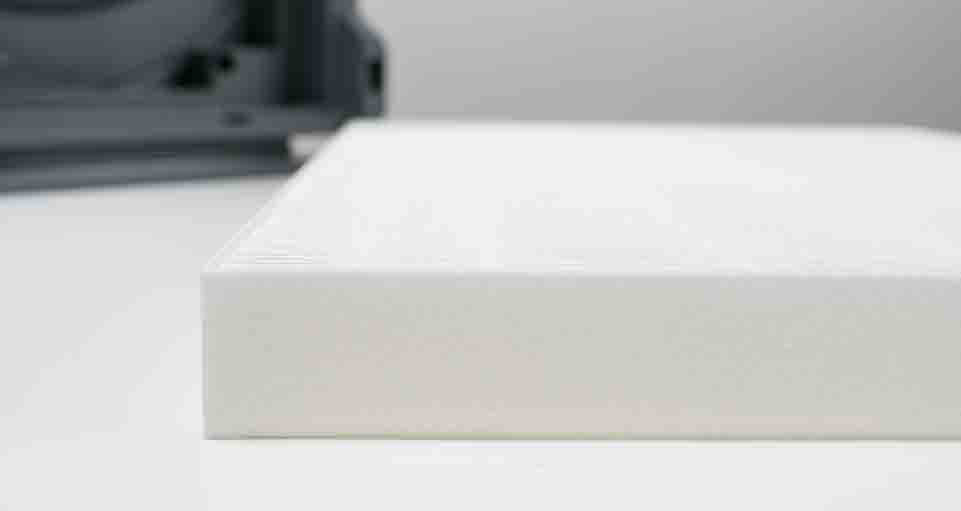
Gas Filter
Like most other air purifiers on the market, the Winix 5300-2 comes equipped with a carbon filter for gas filtration. The carbon bonds to unwanted gases like odors and VOCs to remove them from the air that travels through the filter.
The 5300-2’s carbon filter is comprised of a fibrous material that is coated with carbon. This is the most common type of carbon filter on the market. The Coway Mighty and GermGuardian AC4825 are equipped with the same type of filter.
You should be aware that there is a second type of carbon filter available. This carbon filter type is comprised of carbon pellets held inside a plastic honeycomb frame. The carbon pellets offer better gas adsorption than the coated carbon of the first type of carbon filter we described above.
The second type – a carbon pellet-based carbon filter – can be found in the Winix 5500-2 and Coway AirMega 400. If you’re especially concerned about gas filtration then you should definitely consider spending a little bit extra to move up to the Winix 5500-2. This difference in carbon filter type is one of the largest differences between the 5300-2 and the 5500-2.
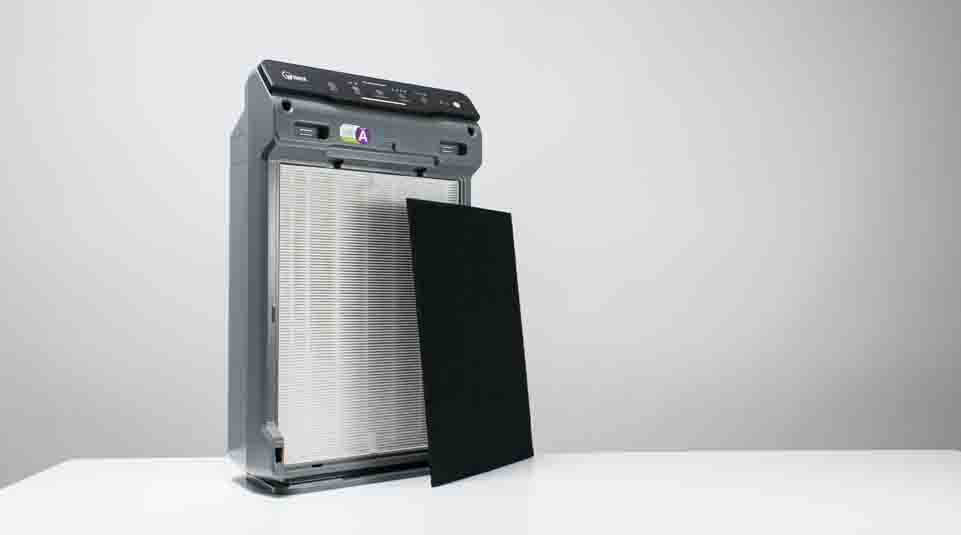
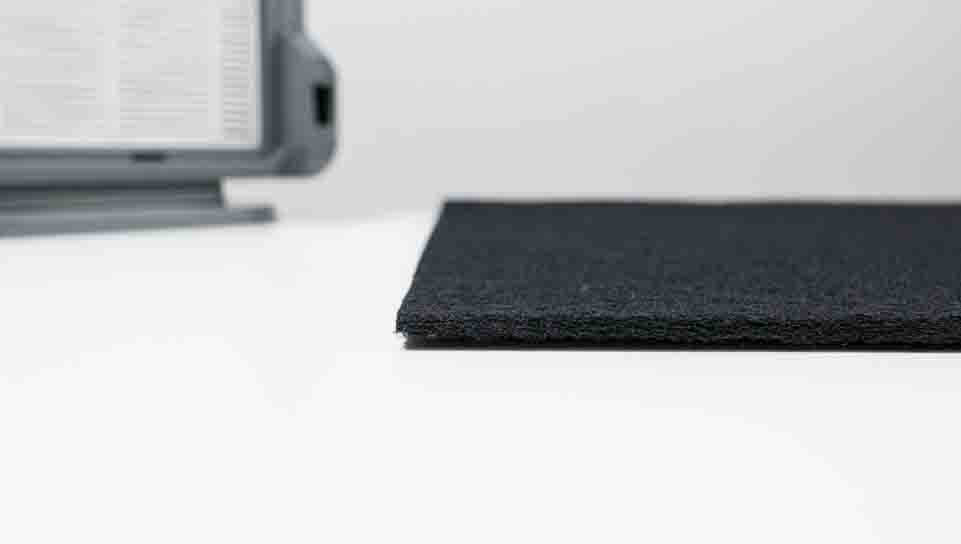
Pre-filter
The Winix 5300-2 is equipped with a washable mesh pre-filter. The pre-filter’s job is to capture larger particles. Larger particles can quickly saturate a HEPA filter so the pre-filter acts to extend the life of the HEPA filter. Large particles build up on the pre-filter which can be washed for free. Only small particles build up on the HEPA filter which has to be replaced at cost.
The Winix 5500-2, Coway Mighty, and AirMega 400 all have the same type of mesh washable pre-filter. The GermGuardian AC4825 and most other budget air purifiers do not. The AC4825 relies on its carbon filter to also act as a pre-filter. The problem with this setup is that the carbon filter can quickly saturate with large particles and has to be replaced at cost. It cannot be vacuumed and washed like the washable mesh pre-filter of the Winix 5300-2.
Air Movement
The 5300-2 processes approx. 250 cubic feet of air every minute – 250 CFM. The 5500-2 and Coway Mighty have essentially the exact same output – 250 CFM.
Less expensive air purifiers like the GermGuardian AC4825 usually have less output. The AC4825 outputs at approx. 130 to 140 CFM. Larger more expensive units like the Coway AirMega 400 usually have greater output. The AirMega 400 outputs at approx. 430 CFM.
The 5300-2’s 250 CFM of air processing power allows it to comfortably be used in spaces as large as 300 sq. ft. on its highest fan speed. Do note that on this fan speed it does produce a lot of noise. On lower settings its much quieter but can only be used in rooms up to about 150 sq. ft.
For spaces larger than 300 sq. ft. we recommend multiple 250 CFM units. We do not recommend a high CFM unit like the AirMega 400 as it’s a very poor value. You can buy almost three 5300-2s for a total output of 750 CFM for the same price as a single AirMega 400.
Energy Efficiency
The 5300-2 has very good energy efficiency. On its highest fan speed it draws 64.4 watts of power. This is slightly worse than the 5500-2 which draws only 54.8 watts of power on the same fan speed. But, it’s slightly better than the Coway Mighty which draws 72.3 watts of power on the same setting.
Recall that the 5300-2 outputs at 250 CFM. It draws 64.4 watts of power at this output. This gives it a CFM/watt ratio of 3.87. Most budget air purifiers have a ratio in the 2 to 3 range on maximum fan speed. In other words, such units are less energy efficient on their highest setting.
Where the 5300-2 really shines is on lower fan speeds. On its second highest setting it draws only 9.9 watts of power and still outputs at approx. 100 to 120 CFM. This gives it a CFM/watt ratio close to 12 on the second highest setting. This is extremely energy efficient. Remember, budget units have a ratio in the 2 to 3 range on maximum fan speed. On this fan speed such units usually max out at about 120 to 140 CFM – approx. the same CFM as the 5300-2 on its second highest setting.
All of this is to say that the 5300-2 is at least 4 times more energy efficient than most budget air purifiers when each unit (the 5300-2 and the budget unit) is set to output at approx. 120 CFM.
Noise Output
The 5300-2 is also one of the quieter air purifiers we’ve tested.
On maximum fan speed it does produce quite a bit of noise. It was measured at 67.5 dB of noise output on turbo. This is the exact same number as the 5500-2 on the same setting – 67.5 dB. The Coway Mighty was ever so slightly quieter. It was measured at 66.1 dB of noise output.
Setting the 5300-2 to any one of the three lower fan speeds greatly reduces noise output. On its second highest fan speed noise output goes all the way down to 49.4 dB. The 5500-2 and Coway Mighty were both measured at 48.9 on the same setting.
Recall that these 250 CFM units output at approx. 100 to 120 CFM on this second highest setting. A smaller budget air purifier needs to be set to its highest fan speed to achieve the same level of output. On this highest fan speed it produces much more noise than the approx. 48 to 48 dB of the Winix 5300-2, 5500-2, and Coway Mighty. For example, the GermGuardian AC4825 was measured at 61.2 dB on maximum fan speed at approx. 130 CFM of output. The Honeywell HPA100 was measured at 68.7 dB on maximum fan speed at approx. 110 CFM of output.
All of this is to say that a 250 CFM unit like the 5300-2 can be set to a lower fan speed to run very quietly and still offer a reasonable amount of output – approx. 100 to 120 CFM. This level of output can properly reduce particle concentration in a 150 sq. ft. and properly maintain low particle concentration in a larger room (you’ll need to initially run the air purifier on turbo to lower particle concentration in a large room but can then set it to a lower fan speed to maintain that lower particle concentration).
A smaller budget priced unit will always run loudly. It has to be set to its highest setting to be effective even in a relatively small room of approx. 150 sq. ft. On lower settings where it runs more quietly it will have so low of an output that it will be ineffective lowering and even maintaining low particle concentration in a small room.
Durability
The 5300-2 like the 5500-2 is one of the few air purifiers on the market that is made in Korea. Most other units, including all Coway units, GermGuardian units, Honeywell units, etc. are made in China.
With this in mind it shouldn’t surprise you that we found both the 5300-2 and 5500-2 to be better built with better quality parts than most other air purifiers on the market. Everything from their control panels to the plastic parts used to construct their chassis is just a cut above in quality compared to comparable parts on most other air purifiers, especially units selling at the same price point.
That being said, both Winix units do come with a very short warranty – it only lasts for 1 year. Most other air purifiers on the market come with a longer warranty. Coway units come with a 3 year warranty. Honeywell units come with a 5 year warranty. Even budget priced GermGuardian units come with a 3 year warranty.
Ease of Use
Like the 5500-2 and the Coway Mighty, the 5300-2 does not give you the option to turn all of its control panel lights off. There is a sleep mode but it is a full auto mode, meaning you cannot control the fan speed when its set to sleep mode. There’s also an LED that illuminates to show that it’s on sleep mode so even on sleep mode there’s always at least one LED that illuminates.
If you do need to use this unit in a dark room and you’re sensitive to lights you have three options:
- You can tape over the LEDs.
- You can rotate the air purifier so that the control panel isn’t pointing towards you while you’re sleeping. The air purifier will work just as well no matter how it’s rotated.
- You can purchase a different air purifier.
The problem with option 3 is that there really isn’t any air purifier currently on the market that’s nearly as good of a value with the same amount of output (CFM), high quality filtration, energy efficiency, and low noise output as the Winix 5300-2, 5500-2, and Coway Mighty. And all three of these units have control panel LEDs that cannot be turned off.
At the same output (and therefore the same area of coverage) you can look at the Honeywell HPA200 or HPA300. You could also consider the Austin Air HealthMate. The issue here is that the Honeywells simply aren’t very good air purifiers and the Austin is primarily intended for unwanted gas filtration and is quite expensive (approx. $500).
The Winix 5300-2 is a highly portable appliance. It only weighs about 15 lb. There’s a single handle on the back of the air purifier to pick it up. Two handles would have been nice but the single handle works well enough to easily pick the unit up to move it from one location to the next. The 5500-2 is identical in size although it is slightly heavier (about 16.5 lb.) because of its more substantial carbon filter. The Coway Mighty is lighter (12.5 lb.) and also slightly smaller in size.
All three units – the 5500-2, 5300-2, and Mighty – have a timer to turn off the air purifier on a delay.
The 5500-2 comes with a remote while the 5300-2 and Mighty do not. All three units cannot be controlled wirelessly via an app on your phone. If this is a feature that’s a priority for you be prepared to spend at least a few $100 more for a unit with at least as much output and similar filtration quality as these three units that can also be controlled wirelessly via an app.
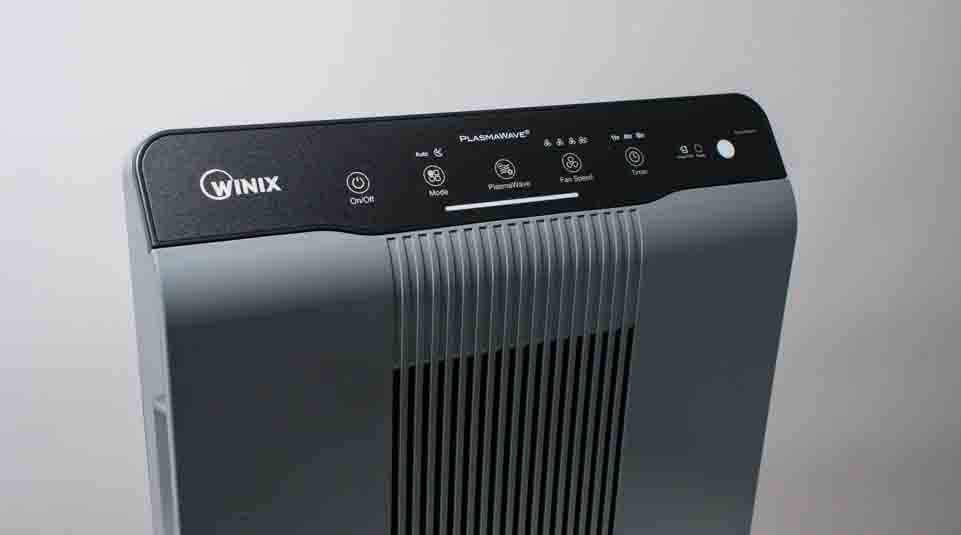
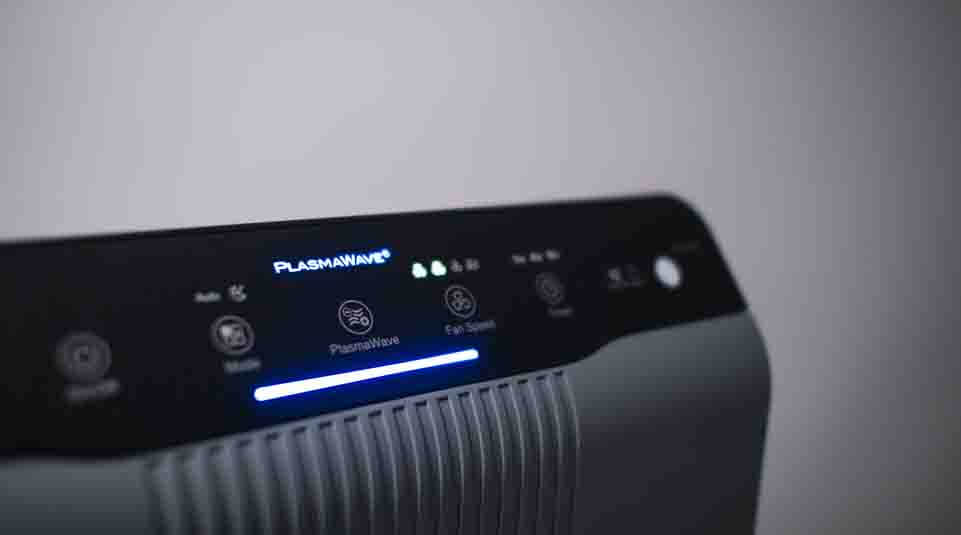
Value
The 5300-2 is one of the best value air purifiers on the market. It’s inexpensive, offers great energy efficiency and its filters are very reasonably priced as well.
At approx. $130 it is the least expensive 250 CFM unit we’ve tested so far. You cannot buy an air purifier with the same or greater output for less money. The 5500-2 is slightly more expensive at approx. $150 and the Coway Mighty is even more expensive at approx. $210.
Moving up to the 5500-2 you gain slightly better gas filtration and a remote. Moving up to the Coway you gain 2 more years on the unit’s warranty.
Is a remote and/or better gas filter enough of a reason for you to spend slightly more for the 5500-2? Yes, we believe it is for most users. This is the reason why the 5500-2 and not the 5300-2 is usually our recommendation as one of if not the best air purifier option on the market today.
Is its longer warranty enough of a reason for you to spend even more for the Coway? No, we don’t believe it is. That being said, the Coway is still a great air purifier and it’s still a good value. It’s also a different brand – a more pronounced alternative - to the 5500-2 which is the reason we usually recommend it as the second best option behind the 5500-2.
That all being said, the 5300-2 is still a great air purifier and a tremendous value. If your primary concern is particle filtration then it will perform just as well as the 5500-2 and Coway Mighty. It has the exact same output at approx. 250 CFM so it will be able to cover the exact same size area just as well. It has the exact same type of particle filter – a HEPA filter. So, it will clean the air (from particles) just as well as the 5500-2 and Mighty. Get the 5300-2 instead of the 5500-2 if gas filtration and a remote are not that important to you.
Add a Comment
Have a question or comment? Let us know below.

Comments (3)
I have owned one of these for two years and just ordered another one. Dollar for dollar for a 360 sq ft approx coverage size, I don't think you can do much better. Filter replacements are reasonable compared to many other models/brands.
We also have a Honeywell air purifier that works for the same general area/size. It's good too, but I really like the filter sensor lights that go red when the air is dirty. If you have any doubts about the efficiency and the way the lights work, go buy one. Then, with it running in a room, squat down and put some personal breeze into it. Then turn around. That blue bar just went red!! Bad dog!! LOL
I also like that this unit tells you when the filters need changed/cleaned on all levels.
Here's my final comment/tip. You can make you machine's filters last longer if you lay the unit on it's back, open the front panel, and use your home vacuum brush to carefully gently go up and down that prefilter.
I can't think of the last time I went on the internet and recommended something. This 5300-2 deserves your attention for these reasons: reasonable price (found new ones on ebay delivered for less than $140), low operating cost/power usage/low replacement cost for filters. I rest my case.
Do you test ozone level?
We do not. For ozone emission data I recommend this resource.
I purchased the Winnix 5300-2. My Belkin watt meter indicates about 55 watts usage on 5300-2 turbo setting with plasmawave on.
It would be nice if there was a light sensor bypass to leave the unit on in auto without going into sleep mode when the lights are out.
A question I have is, how do you know the plasmawave is actually functioning aside from the indicator light? I see no discernable increase/decrease in watts with plasmawave function on/off on my unit.
The easiest way to tell if the ionizer is working is to smell the air in the room. It should smell different in the room with the ionizer turned on compared to when it's off.